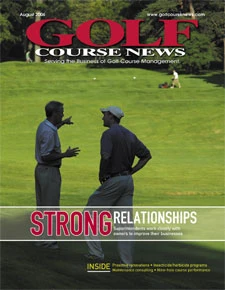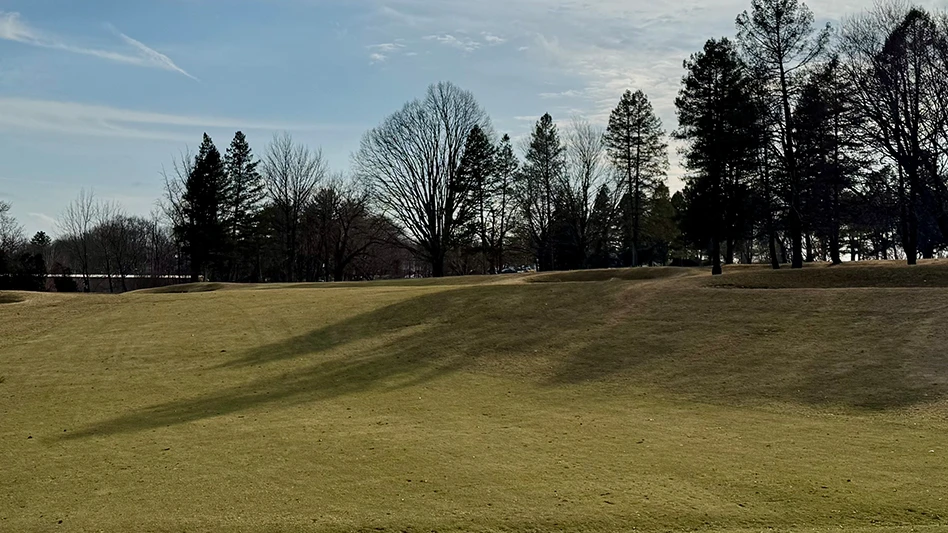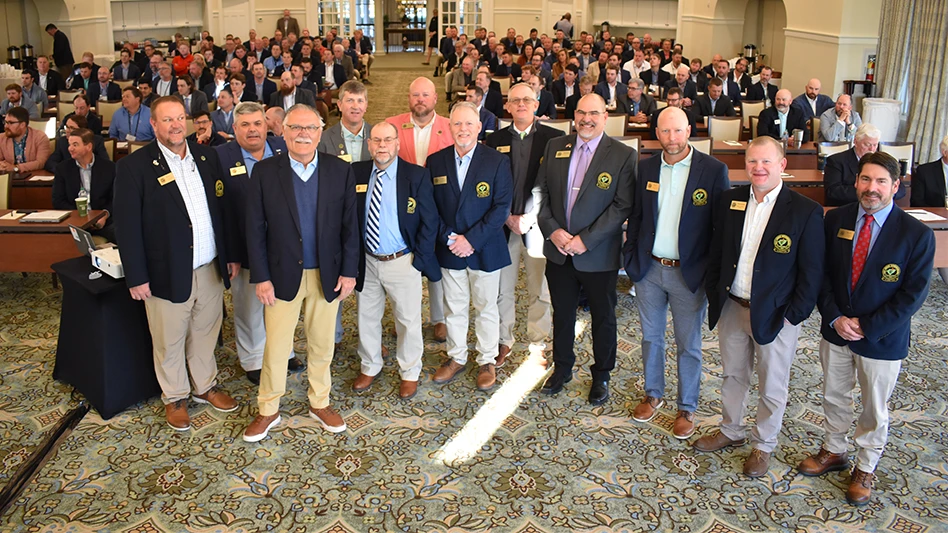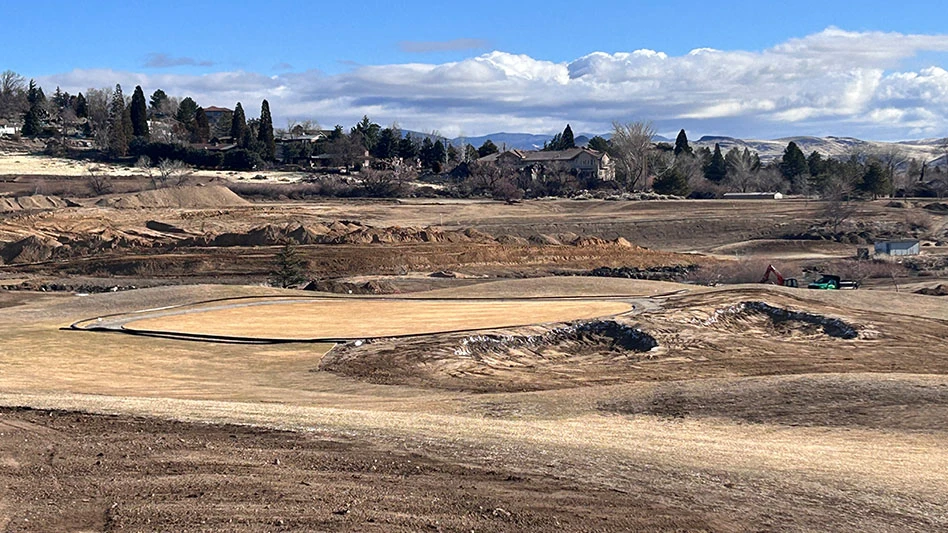Many courses are remodeling tees to improve them to the best condition possible, but they need to be practical and functional.
In the early days of golf, golfers simply teed up on greens. Golfers soon realized a separate tee, distant from the previous green, improved safety, speed of play and provided a level starting point. However, tee boxes in the early days were small and had little artistry or sophistication. They eventually became larger to reduce wear and elongated to provide shorter playing options. Multiple tee complexes evolved and put each player on a smaller tee with an old-time feeling. Tees also became style elements, varying from elevated to sunken surrounding earth forms, and were often integrated with surrounding landscape to assume artistic forms equal to greens and bunkers.
Currently, functional and easy-to-maintain tees are fashionable. Our clients ask for detailed tee designs to make tee maintenance easier. They want adequate size, but because every square foot of tee costs money to construct and maintain, we’re rethinking the “bigger is better” mentality because smaller tees save mowing time.
How big?
Based on experience, we favor the higher end of the recommended standard of 150 to 200 square feet per 1,000 rounds for tee surfaces. In most cases, 4,000-square-foot tees for private clubs with limited play (20,000 rounds), and 6,000- to 8,000-square-foot tees on public courses with more play (40,000 rounds) work well. Facilities might need to accommodate the busiest month of play at one square foot of space for every 1,000 rounds. For example, if a Minnesota course generates 30,000 rounds annually, 7,500 of which are in its busiest month, it might need 7,500-square-foot tees rather than the suggested 4,500- to 6,000-square-foot tees.
We also adjust individual tees based on construction method, arrangement (multiple tees require more space than runway tees because there’s unusable space at the ends of each tee) and microclimate. Starting holes, par 3s, short par 4s with a lot of iron use and holes with forced carries are increased to 250 square feet per 1,000 rounds.
Recently, I detailed how a trend toward longer courses was driven by a miniscule number of players and how that inadvertently might make courses too long (July issue, page 18). While improving tee conditions, take the opportunity to find additional back-tee length where possible and adjust middle- and front-tee length to adapt the course better to the majority of members. Generally, these yardages should be about 7,400 or longer; 6,700; 6,100; 5,500 and 4,500 yards.
However, achieving those lengths is just a partial answer to tee design. To minimize tee space, distribute tee size correctly among multiple tees to match play. Visit www.growingthegame.org to view research about course length preferences by Frank Thomas – former USGA technology guru who’s currently an independent consultant. I’ve interpolated Thomas’ data and others’ to comprise the chart below.
Using the chart, a course that generates 20,000 rounds might end up with rectangular tees of the following dimensions:
Black tees: 15 feet by 15 to 20 feet. Championship tees generally generate light play and can be as small as you can mow, especially on a course that’s 7,100 yards or longer.
Blue tees: 30 feet by 30 feet, with occasional use of the front for white tee markers.
White tees: 30 feet by 85 feet, 35 feet by 75 feet, 40 feet by 65 feet or 45 feet by 60 feet. The extra width helps with heavier play. Generally, for play and maintenance, extra length is more beneficial than extra width, allowing tee settings to match pin settings to keep length consistent daily.
Green tees: 30 feet by 30 to 40 feet, with occasional use of the back for white tee markers to reduce white tee size.
Red tees: 20 feet by 20 feet. We hesitate to undersize red tees because many women are sensitive to the size of tees and the number of women golfers is increasing. Experience shows forward tees don’t need to be larger on par-3 holes because they don’t cause as much damage.
Efficiencies
Rectangular and simple curvilinear tees can minimize tee size because they maximize useable area. Rectangular tees are useable side to side. The front and back areas of round tees are too narrow for tee markers, and round tees add 5 percent to the space needed. Free-form tees are attractive, but add even more space. The old runway tees reduce starts and stops and mowing time, but are less attractive to golfers.
Some dimensions are more maintenance efficient than others. Fifteen feet is the minimum tee-marker spacing, so one can achieve two tee settings side to side with 30-foot tees. Tee markers must move a yard daily for 30 days to recover. Using the minimum tee-marker space on weekdays (about 20 days) and full width on weekends (about 10 days) lets a 30-foot-wide tee be only 22 yards from front to back, whereas a 25-foot-wide tee must be 51 to 96 feet long – an increase of 12 percent to 15 percent in tee construction and maintenance costs.
Designing tee widths to match tee mowers (about 5-feet wide with overlap) minimizes mowing passes. If a 15-foot-wide championship tee can be mowed in three passes, why provide 17 feet? Because tees are often cross mowed, tee lengths in the next largest five-foot multiples than required might decrease mowing passes. Using an even number of passes might bring one back out in the same place he started, saving travel time.
Using the precise measurements outlined above might save construction and maintenance costs when rebuilding tees. GCN
Get curated news on YOUR industry.
Enter your email to receive our newsletters.
Explore the August 2006 Issue
Check out more from this issue and find your next story to read.
Latest from Golf Course Industry
- Atlanta Athletic Club approves funding for master plan
- PBI-Gordon introduces new field development team
- The Cabot Collection announces move into course management
- Carolinas GCSA raises nearly $300,000 for research
- Advanced Turf Solutions’ Scott Lund expands role
- South Carolina’s Tidewater Golf Club completes renovation project
- SePRO to host webinar on plant growth regulators
- Turfco introduces riding applicator






